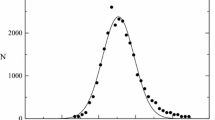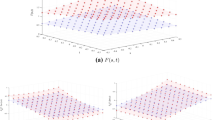Abstract
The paper considers an approach to formulating and finding solutions to scalar diffusion equations taking into account the fuzzy perception of the timeflow in the processes of propagation of physical substances and information flows. The description of an unconventional method of time accounting is based on the use of fuzzy structured numerical sets, which is based on the principle of forming a fuzzy original with its subsequent replication on the numerical axis. The formalization of the fuzzy original is to define two functions parametrically set on the interval [0, 1] that determine the rate of the subjective perception of a time unit. The diffusion equation describing the information dissemination in the social environment is proposed and analyzed. A solution is obtained that determines the state of the propagation process taking into account the “fast” and “slow” time flows. The proposed methodology allows us to formalize the problem of fuzzy description taking into account the subjective perception of time accounting when solving various dynamics problems.
Similar content being viewed by others
References
V. V. Razin and A. F. Tuzovskiy, “Representation of temporal knowledge in Semantic Web ontologies considering knowledge uncertainty,” Proc. of TUSUR University, Iss. 2 (28), 157–162 (2013).
L. A. Zadeh, “The concept of a linguistic variable and its application to approximate reasoning,” Inform. Sci., Vol. 8, No. 3, 199–249 (Part I); Vol. 8, No. 4, 301–357 (Part II); Vol. 9, No. 1, 43–80 (Part III) (1975).
S. A. Orlovsky, Decision-Making Problems with Fuzzy Initial Information [in Russian], Nauka, Moscow (1981).
S. O. Mashchenko, “A mathematical programming problem with the fuzzy set of indices of constraints,” Cybern. Syst. Analysis, Vol. 49, No. 1, 62–68 (2013). https://doi.org/10.1007/s10559-013-9485-4.
Yu. P. Pyt’ev, Possibility: Elements of Theory and Application [in Russian], Editorial URSS, Moscow (2000).
A. Kaufmann, Introduction à la Théorie des Sous-Ensembles Flous à l’Usage des Ingénieur (Fuzzy Sets Theory), MASSON, Paris–New York–Barcelone–Milan (1977).
S. Nahmias, “Fuzzy variables,” Fuzzy Sets and Systems, Vol. 1, No. 2, 97–110 (1978).
E. V. Ivokhin and M. F. Makhno, “On an approach to construction of structured fuzzy sets and their application for description of fuzzy time response,” J. Autom. Inform. Sci., Vol. 49, Iss. 10, 55–63 (2017). https://doi.org/10.1615/JAutomatInfScien.v49.i10.60.
B. Jana and T. K. Roy, “Multi-objective fuzzy linear programming and its application in transportation model,” Tamsui Oxford J. of Math. Sci., Vol. 21, No. 2, 243–268 (2005).
E. V. Ivohin, “Formalization of influence processes of fuzzy time flow on the solution to time resource distribution problems,” Cybern. Syst. Analysis, Vol. 57, No. 3, 363–373 (2021). https://doi.org/10.1007/s10559-021-00361-x.
A. Sadeghi, A. I. M. Ismail, A. Ahmad, and M. E. Abbasnejad, “A note on solving the fuzzy Sylvester matrix equation,” J. of Computational Analysis and Applications, Vol. 15, No. 1, 10–22 (2013).
I. G. Aramanovich and V. I. Levin, Equations of Mathematical Physics [in Russian], Nauka, Moscow (1969).
B. V. Bondarev, N. P. Kalashnikov, and G. G. Spirin, General Physics Course: in 3 Vol., Vol. 3: Thermodynamics, Statistical Physics, Structure of Matter [in Russian], Yurait, Moscow (2015).
Å. V. Ivokhin and Yu. À. Naumenko, “On formalization of information dissemination processes based on hybrid diffusion models,” J. Autom. Inform. Sci., Vol. 50, Iss. 7, 79–86 (2018). https://doi.org/10.1615/JAutomatInfScien.v50.i7.70.
E. V. Ivokhin, L. T. Àdzhubey, and O. V. Gavrylenko, “On the formalization of dynamics in information processes on the basis of lnhomogeneous one-dimensional diffusion models,” J. Autom. Inform. Sci., Vol. 51, Iss. 2, 22–29 (2019). https://doi.org/10.1615/jautomatinfscien.v51.i2.30.
F. Brauer and C. Kribs, Dynamical Systems for Biological Modeling: An Introduction, Chapman and Hall/CRC, New York (2015).
E. Hairer, S. Nørsett, and G. Wanner, Solving Ordinary Differential Equations I: Nonstiff Problems, Springer-Verlag (1987).
Author information
Authors and Affiliations
Corresponding author
Additional information
Translated from Kibernetyka ta Systemnyi Analiz, No. 6, November–December, 2021, pp. 61–71.
Rights and permissions
About this article
Cite this article
Ivohin, E.V., Voloshyn, O.F. & Makhno, M.F. Modeling of Information Dissemination Processes Based on Diffusion Equations with Fuzzy Time Accounting. Cybern Syst Anal 57, 896–905 (2021). https://doi.org/10.1007/s10559-021-00416-z
Received:
Published:
Issue Date:
DOI: https://doi.org/10.1007/s10559-021-00416-z




